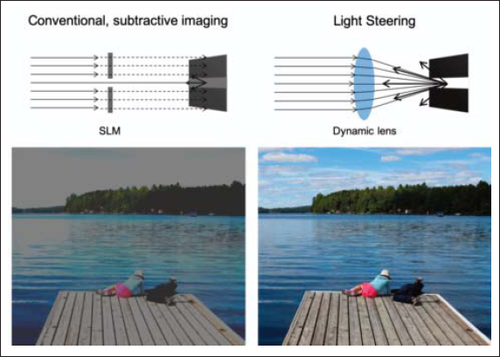
Light Steering technology: BARCO
May 25 2023
Tech developer Barco has brought its new HDR Lightsteering cinema projector to Cannes, previewing the system for filmmakers in advance of a rollout that is expected to begin in early 2024.
This “lightsteering” technology is an option that Barco believes would give moviegoers a brighter, HDR image — therefore a wider creative palette for filmmakers — compared with most of today’s laser-projection systems.
HDR technology is popular OTT streaming platforms with color space Rec 2020.
Currently Theatrical projection have a standard dynamic range with DCI p3 color space.
Recently there are news about LED theatres which can project HDR content.
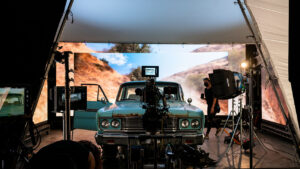
But theatres converting to LED screens is going to be tedious and very expensive.
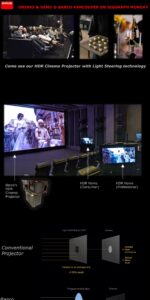
Barco HDR content creation team and the directors of the different submissions; the titles were regraded to take full advantage of the enhanced capabilities of the high dynamic range format and the Lightsteering projection technology.
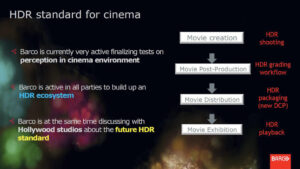
Barco’s HDR Lightsteering is a projection technology that allows bringing next generation premium image quality to cinema auditoriums. In the future, it will offer both brighter highlights and darker black levels, to enable a higher dynamic range in the image. It does this by making efficient use of laser-generated light through smart steering; leading to a projection setup that combines backwards compatibility with cinema operations and future-proofness for HDR content and premium experiences.
This gives moviemakers more degrees of freedom and a broader palette to work with.
Barco’s HDR Lightsteering technology has already amazed audiences at multiple studio demos and US film festivals. Now BARCO to bring this technology for the first time ever to the European community of creatives and studios, as part of an exclusive showcase during the Cannes Film Festival. Over a period of 2 days, Barco is inviting directors, colorists, studio professionals and other representatives of the creative movie community to a demonstration of its HDR Lightsteering technology. The migration to HDR is considered a key driver behind the future of content creation for cinema as well as exhibition. Barco is bringing to the table the most scalable, cinema-centric and viable technology through HDR Lightsteering.
The idea behind light steering is to modulate the light by steering it rather than blocking it—light that is traditionally blocked in dark areas of the image is now redirected toward bright areas, where more light is needed.
Because light-steering systems use all of the light produced by the source, they are efficient and cost-effective. Fig. 1 illustrates the concept of light steering. The conventional, subtractive projector in Fig. 1(a) blocks a large amount of light at the SLM. The light steering system in Fig. 1(b) will redirect all incoming light using a dynamic, freeform lens that changes shape for each individual frame.
Details are in the caption following the image
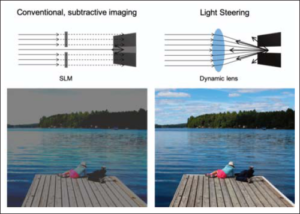
Since the beginning of cinematic entertainment, projection technology has been the only real display used in theaters; only projectors could provide the light power combined with high image quality and accuracy that moviegoers cherish. Modern digital projectors produce images by shining a uniform amount of light onto a spatial light modulator (SLM), typically a digital micromirror device (DMD) or a liquid crystal on silicon (LCoS) chip. To produce colors and shaded regions in the image, light is blocked on a pixel-by-pixel basis. Because of this subtractive approach, no pixel can exceed the luminance of full-screen white (FSW). Considering that most movie image content has a frame average light level (FALL) around 10 percent, it means that around 90 percent of the generated light is thrown away and never reaches the screen. For HDR systems, this waste increases greatly, because FALL values represent an even smaller fraction of peak luminance. Furthermore, SLMs can never completely block all the light, resulting in a more or less fixed contrast ratio, and thus the black level is also linearly related to the FSW.
The projection image-formation model is the main obstacle to reach higher dynamic range. First, it is difficult to illuminate a large screen with high light levels. Second, raising the power (and thus the FSW) does not increase the dynamic range, because it also raises the black level. So, cinema projectors’ dynamic range performance is physically rooted to this light-subtracting approach. To improve the dynamic range significantly, we must implement two major engineering feats:
Increasing power to reach higher FSW;
Increasing the SLM contrast ratio capabilities to reach deeper black levels.
The tech effectively throws more light at parts of the image that require high brightness, but not the darker areas, which the company contends makes their system a more efficient user of light and therefore more cost effective than proposed HDR-capable LED cinema screens.
The company has been presenting this system for more than a year at a bespoke setup in Hollywood to filmmakers and studio execs, after first debuting what was then-developing tech to a limited number of guests in private demos at CinemaCon in 2018.
At Cannes, Barco is showcasing the lightsteering tech with the American Society of Cinematographer’s Standard Evaluation Material II (StEM2) project, titled The Mission, a 16-minute short film that was made to offer a consistent baseline while evaluating a myriad of different technologies and workflows used to produce and display movies and episodic series, with an eye toward maintaining the filmmakers’ intent.
Article edited by
CJ Rajkumar
Author/ Cinematographer
